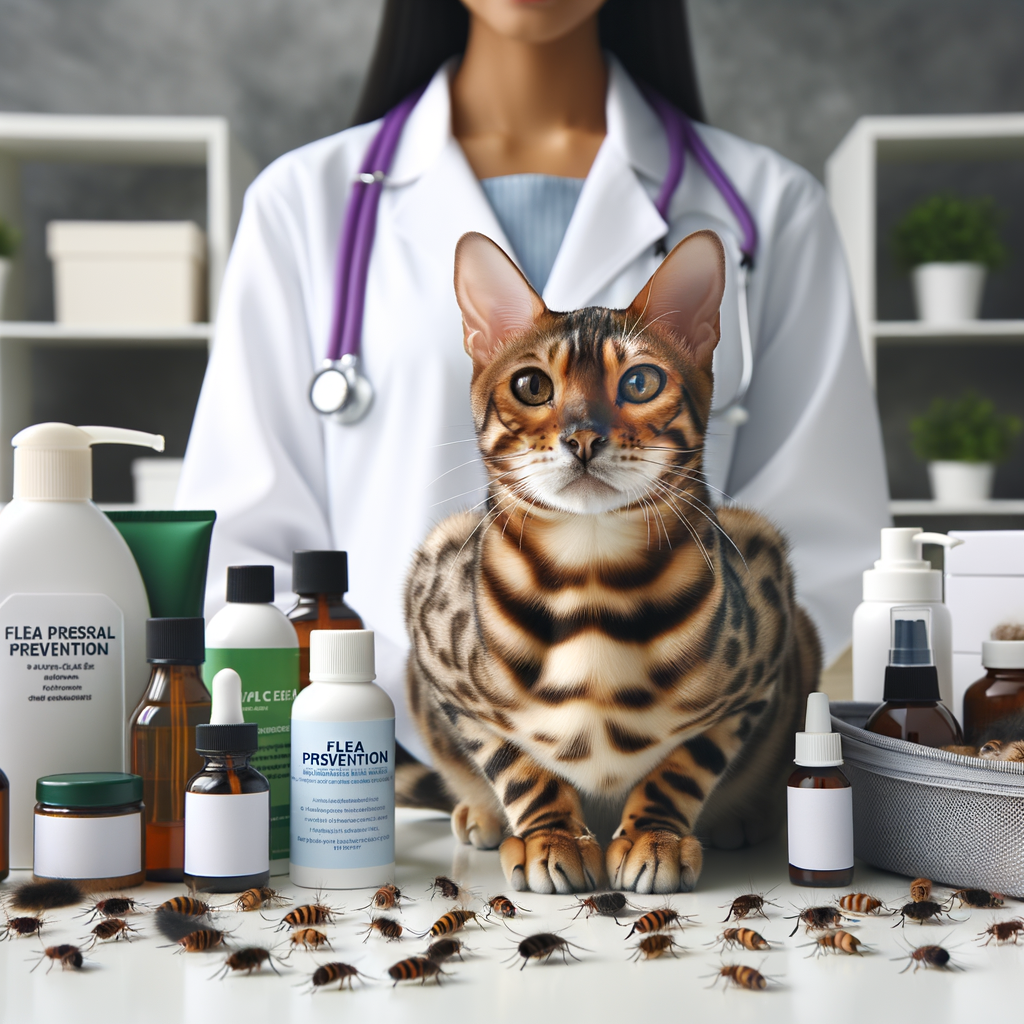
Introduction to Bengal Cat Flea Prevention
-
Understanding the importance of flea prevention for Bengal cats:
Fleas can cause serious health issues, including skin infections and allergic reactions. Keeping your Bengal cat flea-free ensures they stay healthy and happy.
-
Overview of common flea infestation symptoms in Bengal cats:
- Excessive scratching and biting
- Red, irritated skin
- Hair loss
- Visible fleas or flea dirt on the fur
Bengal Cat Flea Treatment: The Basics
Best Flea Control for Bengal Cats
Fleas can be a big problem for Bengal cats. They cause itching and can lead to skin infections. Choose the right flea control products to keep your Bengal cat healthy and happy.
- Review of top-rated flea prevention products for Bengal catsThere are many flea prevention products available. Here are some of the best ones:
Product Type Effectiveness Frontline Plus Topical Highly effective Advantage II Topical Very effective Seresto Collar Collar Long-lasting These products are well-reviewed by both veterinarians and pet owners. They are easy to use and provide long-lasting protection against fleas.
- Case study: Effective Bengal cat flea medicationMeet Luna, a 3-year-old Bengal cat. Luna had a severe flea problem. Her owner tried several products, but nothing seemed to work. Finally, they tried Frontline Plus.
After just one application, Luna’s fleas started to disappear. Within a week, she was flea-free and much happier. Her owner was relieved and now uses Frontline Plus regularly to keep Luna protected.
“Frontline Plus changed Luna’s life. She is now flea-free and much more comfortable.” – Luna’s Owner
Natural Flea Remedies for Bengal Cats
-
Exploring Home Remedies for Flea Prevention
Many pet owners prefer natural remedies to keep fleas away from their Bengal cats. These remedies can be safer and less expensive than chemical treatments.
Here are some popular home remedies:
- Apple Cider Vinegar: Mix equal parts of apple cider vinegar and water in a spray bottle. Spray your cat’s fur lightly. This can help repel fleas.
- Lemon Spray: Boil a sliced lemon in water and let it steep overnight. Spray this solution on your cat’s fur to deter fleas.
- Essential Oils: Oils like lavender and cedarwood can be mixed with water and sprayed on your cat’s fur. Be cautious, as some oils can be harmful to cats.
-
Benefits and Drawbacks of Natural Flea Treatments
Benefits Drawbacks Safer for your cat’s health May not be as effective as chemical treatments Less expensive Need frequent application Environmentally friendly Some cats may be allergic to certain ingredients While natural remedies can be a good option, they may not work as well as chemical treatments. Always monitor your cat for any adverse reactions and consult your vet if unsure.
Bengal Cat Flea Prevention Tips
Maintaining a Clean Environment
-
Importance of regular cleaning in flea prevention:
Fleas thrive in dirty environments. Regular cleaning helps remove flea eggs and larvae before they become a problem. Vacuuming carpets, washing pet bedding, and cleaning furniture can significantly reduce the risk of a flea infestation.
-
Key takeaways: Best cleaning practices for Bengal cat owners:
- Vacuum your home at least once a week, focusing on areas where your Bengal cat spends most of its time.
- Wash your cat’s bedding in hot water weekly to kill any flea eggs or larvae.
- Clean and disinfect your cat’s litter box regularly.
- Use flea-preventive sprays or powders on carpets and furniture, but ensure they are safe for pets.
- Keep your yard clean by mowing the lawn and removing debris where fleas might hide.
Regular Vet Check-ups
- Role of regular vet visits in flea preventionVets can spot early signs of flea infestations that you might miss. They also provide expert advice on the best flea prevention methods tailored to your cat’s needs.
According to a study by the American Veterinary Medical Association, cats that see a vet regularly are less likely to suffer from severe flea infestations. This is because vets can recommend effective flea treatments and preventive measures.
- What to expect during a vet check-up for flea controlDuring a vet check-up, the vet will thoroughly examine your Bengal cat for any signs of fleas. This includes checking the fur and skin for flea dirt, bites, and live fleas. The vet may also use a flea comb to catch any hidden fleas.
In addition to the physical exam, the vet might ask about your cat’s behavior and any scratching or biting habits. They may also recommend specific flea treatments or preventive products based on your cat’s health and lifestyle.
Check-up Activity Purpose Physical Examination Identify signs of fleas and skin issues Flea Comb Use Catch hidden fleas Behavioral Questions Understand scratching or biting habits Product Recommendations Suggest effective flea treatments
Flea Collars for Bengal Cats: A Comprehensive Guide
- How Flea Collars Work
Flea collars are a popular choice for preventing fleas on Bengal cats. These collars release chemicals that kill fleas on contact. Some collars also repel fleas, keeping them away from your cat. The chemicals spread over your cat’s fur and skin, providing protection for several months.
There are two main types of flea collars:
- Insecticidal Collars: These release chemicals that kill fleas.
- Repellent Collars: These release substances that repel fleas.
Flea collars are easy to use. Simply put the collar around your cat’s neck, making sure it’s not too tight. You should be able to fit two fingers between the collar and your cat’s neck.
- Pros and Cons of Using Flea Collars for Bengal Cats
| Pros | Cons |
|---|---|
| Easy to use | Some cats may be allergic |
| Long-lasting protection | May not be effective for severe infestations |
| Cost-effective | Can have a strong odor |
Using a flea collar has several benefits. They are easy to use and provide long-lasting protection. This can be very cost-effective compared to other treatments.
However, there are some downsides. Some cats may be allergic to the chemicals in the collar. Also, flea collars might not be effective if your cat already has a severe flea infestation. Additionally, some collars can have a strong odor that both you and your cat might find unpleasant.
It’s important to monitor your Bengal cat for any signs of irritation or allergic reactions when using a flea collar. If you notice any issues, remove the collar and consult your vet.
Bengal Cat Flea Shampoo: An Essential Tool
-
Choosing the right flea shampoo for your Bengal cat
- Ingredients: Look for shampoos with natural ingredients. Avoid harsh chemicals that can irritate your cat’s skin.
- Effectiveness: Choose a shampoo that kills fleas at all life stages—eggs, larvae, and adults.
- Brand reputation: Opt for well-known brands with positive reviews from other cat owners.
For example, brands like Adams and Frontline are often recommended for their effectiveness and safety.
- Step-by-step guide on how to use flea shampoo effectively
Using flea shampoo correctly ensures that your Bengal cat gets the best protection. Follow these steps:
- Prepare: Gather all necessary supplies, including the flea shampoo, a towel, and a comb.
- Wet your cat: Use lukewarm water to thoroughly wet your Bengal cat’s fur.
- Apply shampoo: Gently massage the flea shampoo into your cat’s fur, starting from the neck and working your way down to the tail.
- Wait: Allow the shampoo to sit for the recommended time (usually 5-10 minutes) to ensure it kills all fleas.
- Rinse: Rinse your cat thoroughly with lukewarm water to remove all traces of shampoo.
- Dry: Use a towel to gently dry your cat. Avoid using a hairdryer as it can scare your cat.
- Comb: Use a flea comb to remove any dead fleas and flea dirt from your cat’s fur.
By following these steps, you can effectively use flea shampoo to keep your Bengal cat flea-free and comfortable.
| Step | Action |
|---|---|
| 1 | Prepare all supplies |
| 2 | Wet your cat’s fur |
| 3 | Apply shampoo |
| 4 | Wait for 5-10 minutes |
| 5 | Rinse thoroughly |
| 6 | Dry with a towel |
| 7 | Comb out dead fleas |
Dealing with a Bengal Cat Flea Infestation: Solutions and Tips
Immediate Steps to Take
- Identifying a flea infestation in your Bengal catFirst, check your Bengal cat’s fur and skin. Fleas are tiny, brown insects that move quickly. Look for flea dirt, which looks like small black specks. You can use a flea comb to help find them.
Watch for signs like excessive scratching, biting, or licking. Your cat may also have red, irritated skin or hair loss. If you see these signs, your cat might have fleas.
- Immediate actions to control the infestationOnce you identify fleas, act quickly. Start by giving your Bengal cat a bath with flea shampoo. This will kill many of the fleas on your cat.
Next, use a flea comb to remove any remaining fleas. Make sure to clean the comb after each stroke.
Wash your cat’s bedding and vacuum your home thoroughly. This helps remove fleas and their eggs from your environment.
Consider using a flea treatment like a spot-on product or oral medication. These treatments can kill fleas and prevent new ones from infesting your cat.
Long-term Flea Infestation Solutions
-
Implementing a Consistent Flea Control Routine
Keeping your Bengal cat free from fleas requires a consistent routine. Regularly check your cat’s fur for fleas and flea dirt. Use a flea comb to help with this task. Bathing your cat with a flea shampoo can also be effective.
Monthly treatments with flea preventatives are crucial. Products like fipronil or imidacloprid can be very effective. Always consult your vet before starting any treatment.
Here is a simple table to help you keep track of your flea control routine:
Task Frequency Check for fleas Weekly Use flea comb Weekly Flea shampoo bath Monthly Apply flea preventative Monthly -
Preventing Future Flea Infestations in Bengal Cats
Keep your home clean by vacuuming regularly. Fleas can hide in carpets and furniture, so make sure to clean these areas thoroughly.
Wash your cat’s bedding in hot water every week. This kills any flea eggs or larvae that might be hiding there. Consider using flea sprays for your home, but ensure they are safe for pets.
Another good practice is to keep your yard clean. Fleas thrive in tall grass and shaded areas. Mow your lawn regularly and remove any debris where fleas might hide.
By following these steps, you can help ensure your Bengal cat stays flea-free.
Ensuring a Flea-Free Life for Your Bengal Cat
- Recap of Bengal cat flea prevention and treatment strategies:Keeping your Bengal cat free from fleas involves a mix of prevention and treatment. Regularly use flea collars and shampoos designed for cats. Don’t forget to clean your home and yard to remove any flea eggs or larvae. Always check your cat for fleas, especially after they go outside.
- Final thoughts on maintaining a healthy, flea-free environment for your Bengal cat:Regular grooming and cleaning are essential. Use products like flea collars and shampoos regularly. Keep your home clean and vacuum often. With these steps, your Bengal cat can enjoy a happy, healthy life without fleas.
| Strategy | Action |
|---|---|
| Flea Collars | Use a flea collar designed for cats to repel fleas. |
| Flea Shampoo | Bathe your cat with flea shampoo regularly. |
| Home Cleaning | Vacuum and clean your home to remove flea eggs and larvae. |
| Regular Checks | Inspect your cat for fleas, especially after outdoor activities. |






